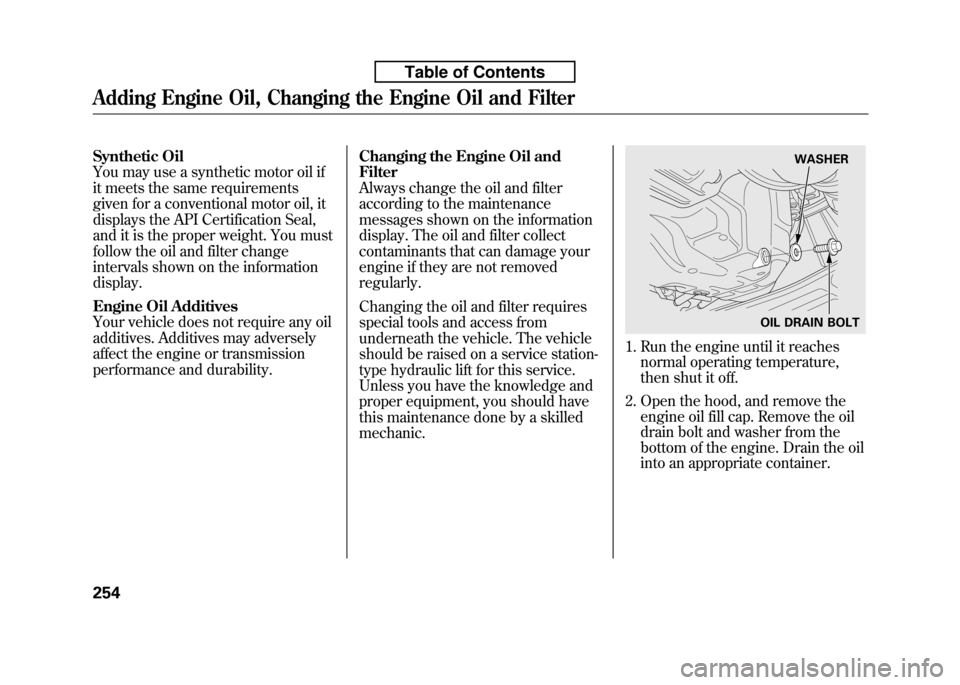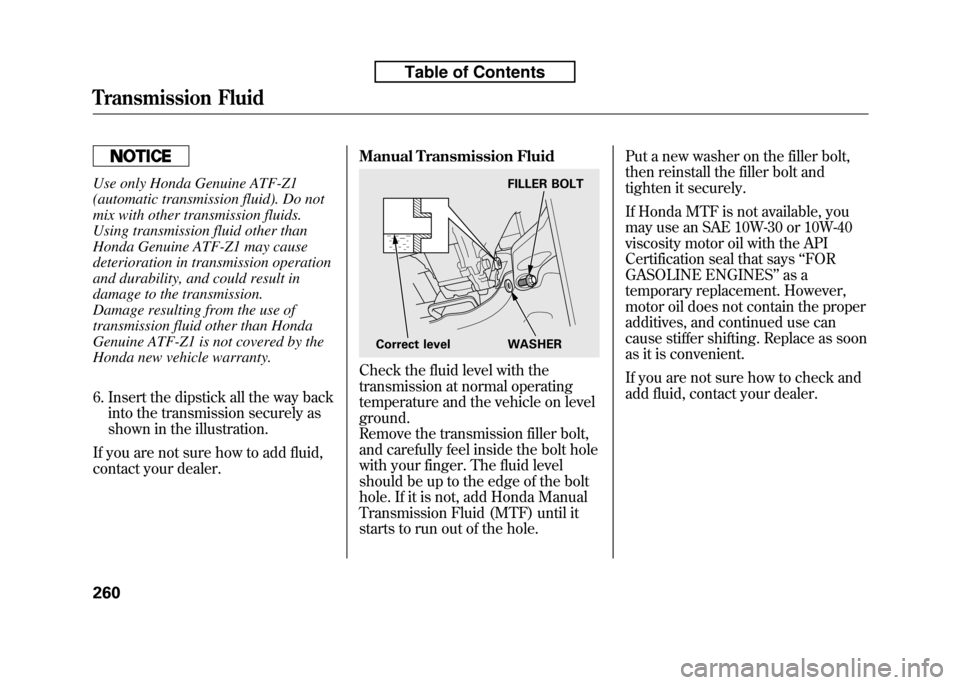2010 HONDA FIT oil additives
[x] Cancel search: oil additivesPage 1 of 351

A
Accessories andModifications ..........................
206
ACCESSORY (Ignition Key Position) ...................................
80
Accessory Power Socket ............
106
Additives, Engine Oil .................
254
Adjusting the Steering Wheel ......
77
Advanced Airbags ........................
27
Airbag (SRS) ............................
9, 22
Air Conditioning System ............
110
Usage ......................................
112
Air Pressure, Tires ..............
273, 274
Alcohol in Gasoline ....................
198
Antifreeze ...................................
256
Anti-lock Brakes (ABS) Indicator ............................
62, 231
Operation ................................
231
Anti-theft, Audio System .............
191
Anti-theft Steering Column Lock .........................................
80
Audio Antenna ...........................
268
Auto Door Locking .......................
83
Auto Door Locking/Unlocking ....
83 Auto Door Unlocking
...................
85
Automatic Seat Belt Tensioners ...
20
Automatic Speed Control ...........
194
Automatic Transmission ............
219
Capacity, Fluid ........................
319
Checking Fluid Level ..............
259
Paddle Shifters ........................
224
Shifting ...................................
219
Shift Lever Position Indicators ............................
219
Shift Lever Positions ...............
220
Shift Lock Release ...................
223
Automatic Transmission Fluid ...
259
Auxiliary Input Jack ...................
190
Average Fuel Economy ................
70
B
Battery Charging System Indicator ........................
60, 303
Jump Starting ..........................
299
Maintenance ...........................
279
Specifications ..........................
320
Before Driving ...........................
197Belts, Seat
................................ 8, 18
Beverage Holders ......................
106
Booster Seats ...............................
50
Brakes Anti-lock Brakes (ABS) ...........
231
Break-in, New Linings .............
198
Bulb Replacement ...................
266
Fluid .......................................
261
Parking ...................................
102
System Design ........................
230
System Indicator ...............
60, 305
Wear Indicators .......................
230
Braking System ..........................
230
Break-in, New Vehicle ................
198
Brightness Control, Instruments ..............................
76
CONTINUED
Index
I
INDEX
Page 213 of 351

Break-in Period
Help assure your vehicle's future
reliability and performance by paying
extra attention to how you drive
during the first 600 miles (1,000 km).
During this period:● Avoid full-throttle starts and rapidacceleration.
● Avoid hard braking for the first 200
miles (300 km).
● Do not change the oil until the
scheduled maintenance time.
You should also follow these
recommendations with an
overhauled or exchanged engine, or
when the brakes are replaced. Fuel Recommendation
Your vehicle is designed to operate
on unleaded gasoline with a pump
octane number of 87 or higher. Use of
a lower octane gasoline can cause a
persistent, heavy metallic rapping
noise that can lead to engine damage.
We recommend using quality
gasolines containing detergent
additives that help prevent fuel
system and engine deposits.
In addition, in order to maintain good
performance, fuel economy, and
emissions control, we strongly
recommend, in areas where it is
available, the use of gasoline that
does NOT contain manganese-based
fuel additives such as MMT.
Use of gasoline with these additives
may adversely affect performance,
and cause the malfunction indicator
lamp on your instrument panel to
come on. If this happens, contact your
authorized dealer for service. Some gasoline today is blended with
oxygenates such as ethanol or
MTBE. Your vehicle is designed to
operate on oxygenated gasoline
containing up to 10% ethanol by
volume and up to 15% MTBE by
volume. Do not use gasoline
containing methanol.
If you notice any undesirable
operating symptoms, try another
service station or switch to another
brand of gasoline.
For further important fuel-related
information for your vehicle, or
information on gasoline that does not
contain MMT, visit Owner Link at
owners.honda.com. In Canada, visit
www.honda. cafor additoin
information on gasoine.
Break-in Period, Fuel Recommendation
198
Table of Contents
Page 269 of 351

Synthetic Oil
You may use a synthetic motor oil if
it meets the same requirements
given for a conventional motor oil, it
displays the API Certification Seal,
and it is the proper weight. You must
follow the oil and filter change
intervals shown on the informationdisplay.
Engine Oil Additives
Your vehicle does not require any oil
additives. Additives may adversely
affect the engine or transmission
performance and durability.Changing the Engine Oil andFilter
Always change the oil and filter
according to the maintenance
messages shown on the information
display. The oil and filter collect
contaminants that can damage your
engine if they are not removedregularly.
Changing the oil and filter requires
special tools and access from
underneath the vehicle. The vehicle
should be raised on a service station-
type hydraulic lift for this service.
Unless you have the knowledge and
proper equipment, you should have
this maintenance done by a skilledmechanic.
1. Run the engine until it reaches
normal operating temperature,
then shut it off.
2. Open the hood, and remove the engine oil fill cap. Remove the oil
drain bolt and washer from the
bottom of the engine. Drain the oil
into an appropriate container.
WASHER
OIL DRAIN BOLT
Adding Engine Oil, Changing the Engine Oil and Filter
254
Table of Contents
Page 275 of 351

Use only Honda Genuine ATF-Z1
(automatic transmission fluid). Do not
mix with other transmission fluids.
Using transmission fluid other than
Honda Genuine ATF-Z1 may cause
deterioration in transmission operation
and durability, and could result in
damage to the transmission.
Damage resulting from the use of
transmission fluid other than Honda
Genuine ATF-Z1 is not covered by the
Honda new vehicle warranty.
6. Insert the dipstick all the way backinto the transmission securely as
shown in the illustration.
If you are not sure how to add fluid,
contact your dealer. Manual Transmission Fluid
Check the fluid level with the
transmission at normal operating
temperature and the vehicle on levelground.
Remove the transmission filler bolt,
and carefully feel inside the bolt hole
with your finger. The fluid level
should be up to the edge of the bolt
hole. If it is not, add Honda Manual
Transmission Fluid (MTF) until it
starts to run out of the hole.Put a new washer on the filler bolt,
then reinstall the filler bolt and
tighten it securely.
If Honda MTF is not available, you
may use an SAE 10W-30 or 10W-40
viscosity motor oil with the API
Certification seal that says
‘‘FOR
GASOLINE ENGINES ’’as a
temporary replacement. However,
motor oil does not contain the proper
additives, and continued use can
cause stiffer shifting. Replace as soon
as it is convenient.
If you are not sure how to check and
add fluid, contact your dealer.
FILLER BOLT
Correct level WASHER
Transmission Fluid
260
Table of Contents